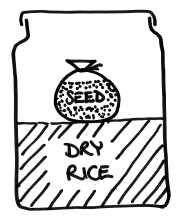click to |
Home Seed Drying & Storage
This is a really important bit. You need to dry your seed out, or it will not keep.
Seed that is air-dry is not really properly dormant - its just napping;
so it is still burning through its stored reserves of energy and will soon run flat - like a mobile phone left on.
Also, you can't put it in a sealed container as it is still breathing - it would suffocate. And without a sealed container, it will soon reabsorb water from the air on the first humid day, and start getting ready to germinate.
How can we dry the seed at home?
We'll use dry rice to suck the water out of the seed & get it really dry. Then it will hibernate completely.
You need to get:
- a big jam-jar with a good lid,
- an old pair of tights,
- a rubber band,
- and some rice
You need to use at least twice as much rice as you have seed. It doesn't matter if you have too much rice, but too little won't work.
 Bake the rice on a tray in the oven for 45 minutes until it is bone dry. While it is still hot, put it in the jam-jar , about half full, and screw the lid on .
Bake the rice on a tray in the oven for 45 minutes until it is bone dry. While it is still hot, put it in the jam-jar , about half full, and screw the lid on .
Wait patiently until the rice is cool. (If you rush this you'll cook your seeds.) So you now have a jam jar 1/2 full of very dry, cool rice.
Put your seed in a bag made by cutting off the foot of the tights, and tie it in with a rubber band. Put it in with the cool dry rice. Put the lid on tightly, so damp air can't get in.
Leave your seed sealed in the jar with the dry rice for a fortnight, and the dampness in the seed will be drawn out into the rice.
You now have bone-dry seed that you can safely seal in a plastic bag, and it will keep for several years.
Passing it Round
This is also important. You will have huge amounts of seed. If you are sure you avoided crossing, and that your plants were nice and healthy, then you have a valuable thing there.
You will get about two and a half kilos of seed from a 20-foot-long bed of 30 plants. Now that's actually three-quarters of a million seeds - and if every one of those was given away or swapped, and then grown, you will have created more than 500,000 kilograms of kale! More than enough to feed all your friends and neighbours, and their families.
So you can see that even one person, on a small scale, can make a real contribution to local food security. Take your spare seed to a local seed swap, or even better, organise your own. Get to gether with your friends or family and set up a seed-circle: one person can grow kale seed, another parsnips, another cucumber, etc etc. You'll all have bags of seed - you can all just swap with each other, so no-one has to save seed from more than a couple of things, yet you all get seed of everything.
It will save you a fortune, and you'll get great, locally-adapted varieties. Just remember, all this is only possible because you are growing real, open-pollinated seed. You can't do this with hybrid (F1) varieties. Funny how the seed companies are so keen on selling you hybrid seed, isn't it?





